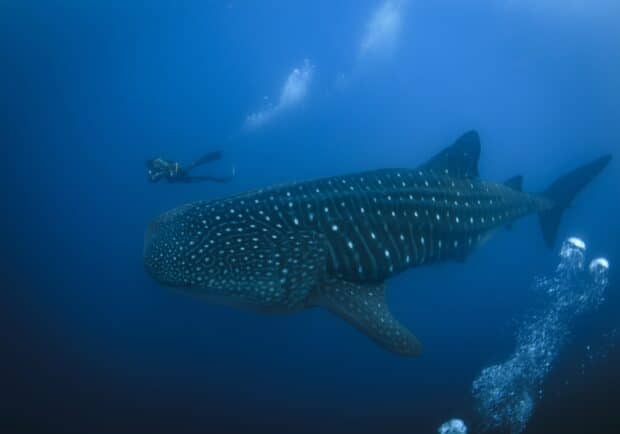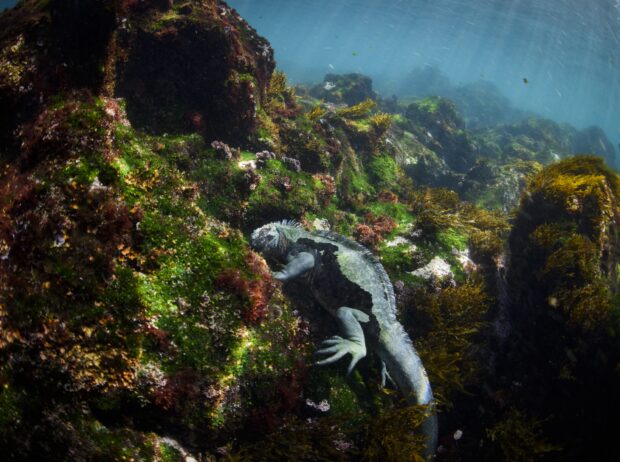
 A whale shark swims through the waters off of Wolf Island, Ecuador, next to Enrique “Quike” Moran, a local naturalist from Santa Cruz Island, Ecuador in the Galapagos on Sunday, June 9, 2024. (Associated Press Photo/Alie Skowronski)
A whale shark swims through the waters off of Wolf Island, Ecuador, next to Enrique “Quike” Moran, a local naturalist from Santa Cruz Island, Ecuador in the Galapagos on Sunday, June 9, 2024. (Associated Press Photo/Alie Skowronski)
GALÁPAGOS ISLANDS, Ecuador — Warm morning light reflects from the remains of a natural rock arch near Darwin Island, one of the most remote islands in the Galapagos. In clear, deep blue water, thousands of creatures – fish, hammerhead sharks, marine iguanas – move in search of food.
The 2021 collapse of Darwin’s Arch, named for the famed British naturalist behind the theory of evolution, came from natural erosion. But its demise underscored the fragility of a far-flung archipelago that’s coming under increased pressure both from climate change and invasive species.
Warming oceans affect the food sources of many of the seagoing animals in the Galapagos. Marine iguanas – one of many species that are endemic, or unique, to the Galapagos – have a harder time finding the red and green algae they prefer. Sea turtles struggle to nest in warmer temperatures. Raising young gets harder as water warms and fewer nutrients are available.
Article continues after this advertisementWhile the Galapagos are known for a great multitude of species, their numbers aren’t unlimited.
FEATURED STORIES TECHNOLOGY vivo launches V40 Lite with 5000mAh battery covered by 50-month warranty, starts at Php 13,999 TECHNOLOGY Galaxy Buds3 Pro: Delivering tailored sound wherever you go TECHNOLOGY Very mindful, very intuitive: ASUS’ most superior AI PC yet, the Zenbook S 14, empowers you to achieve more“We have something of everything here – that’s why people say the Galapagos is so diverse – but we have a small number of each thing,” said Natasha Cabezas, a naturalist guide.
READ: Galápagos: A fragile paradise
Article continues after this advertisementThe Galapagos has always been sensitive to changes in ocean temperature. The archipelago itself is located where major ocean currents converge – cool from the south, warm from the north, and a cold upwelling current from the west. Then there’s El Niño, the periodic and natural Pacific Ocean warming that affects weather worldwide.
Article continues after this advertisementWhile temperatures vary depending on the season and other naturally-occurring climate events, ocean temperatures have been rising because of human-caused climate change as oceans absorb the vast majority of excess heat in the atmosphere. The ocean experienced its warmest decade since at least the 1800s in the last 10 years, and 2023 was the ocean’s warmest year on record.
Article continues after this advertisementEarly June brings winter in the Southern Hemisphere, and the Cromwell current brings whale sharks, hammerheads, and massive sunfish to the surface. It also provides nutrients for penguins, marine iguanas, and sea lions in search of food. As more of those animals make themselves known this season, scientists are tracking how they fared in the warming of the past year’s El Niño.

 A marine iguana found only in the Galapagos Islands feeds on algae and other plants off of Fernandina Island, Ecuador on Saturday, June 8, 2024. The marine iguana feeds directly from the ocean, making it a good indicator of overall ocean health. (Associated Press Photo/Alie Skowronski)
A marine iguana found only in the Galapagos Islands feeds on algae and other plants off of Fernandina Island, Ecuador on Saturday, June 8, 2024. The marine iguana feeds directly from the ocean, making it a good indicator of overall ocean health. (Associated Press Photo/Alie Skowronski)
El Niño can bring food shortages for some species like marine iguanas and sea turtles, as the warmer ocean means dwindling food sources. Scientists observing the species have noted a significant decline in population numbers during El Niño events.
Article continues after this advertisementMarine iguanas swim like snakes through the water from rock to rock as waves crash against the shore of Fernandina Island. They latch themselves onto the undersea rocks to feed on algae growing there, while sea lions spin around them like puppies looking for someone to play with.
The iguanas were “one of the most affected species from El Niño last year and right now they are still recovering,” said Galapagos Conservancy Director Jorge Carrión.
As rising ocean temperatures threaten aquatic or seagoing life, on land there’s a different problem. Feral animals – cats, dogs, pigs, goats, and cattle, none of them native – are threatening the unique species of the islands.
READ: 260 Chinese boats fish near Galapagos; Ecuador on alert
After the COVID-19 pandemic, many people are abandoning the dogs and cats they wanted to keep them company, Cabezas said.
“If you don’t take care of them they become a problem and now it’s a shame to see dogs everywhere. We have a big problem right now I don’t know what we’re going to do,” she said.
The non-native animals are a special threat to the giant tortoises closely associated with the Galapagos. The tortoises declined dramatically in the 19th century due to hunting and poaching, and authorities have worked to protect them from humans. It’s been illegal to kill a giant tortoise since 1933.
“In one night, a feral pig can destroy all nesting sites in an area,” Carrión said. Park rangers try to visit areas with nesting sites once a day, and kill pigs when they find them. But the pigs are elusive, Carrion said.
Feral cats feed on marine iguana hatchings, and both pigs and cats compete for food with the tortoises.
If invasive species and warming oceans weren’t enough, there’s the plastic that is a widespread problem in the world’s oceans. One recent study reported microplastics in the bellies of Galapagos penguins.
Subscribe to our daily newsletter
“There are no animals in the Galapagos that do not have microplastics in their foodhugeslot,” Carrión said.
TOPICS: Climate change, Galapagos READ NEXT Time to ‘LEVEL UP’ with SM’s Cyber Month 2024 Video game performers will go on strike over AI concerns EDITORS' PICK Heart Evangelista: Woman to woman, I never had a problem with Pia Wurtzbach QC Mayor Belmonte highlights social services in State of City Address WPS: US missile deployment to PH key for combat readiness – US general WPS: US missile deployment to PH key for combat readiness – US general Central Visayas’ most wanted killed in shootout in Argao, Cebu Manila Water Foundation and partners underscore benefits of handwashing MOST READ SC issues TRO vs Comelec resolution on dismissed public officials Tropical Storm Kristine slightly intensifies; Signal No. 2 in 5 areas Walang Pasok: Class suspensions on Wednesday, Oct. 23 LIVE UPDATES: Tropical Storm Kristine View comments